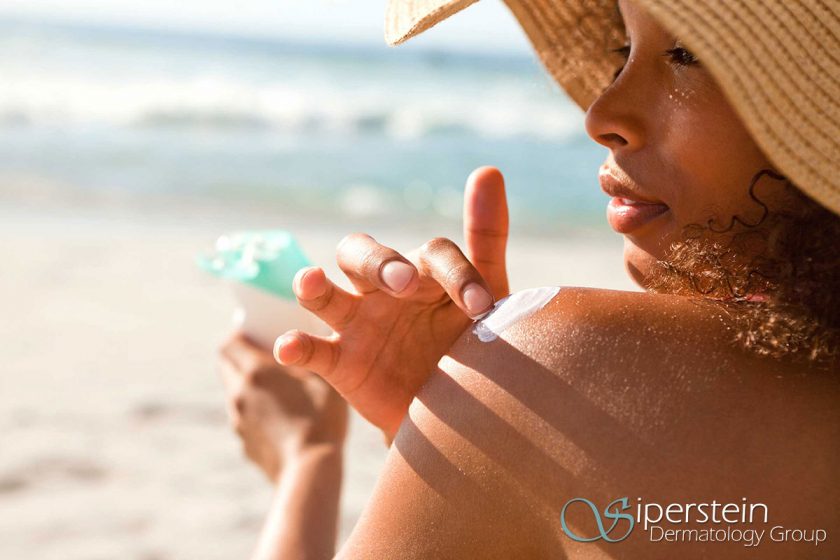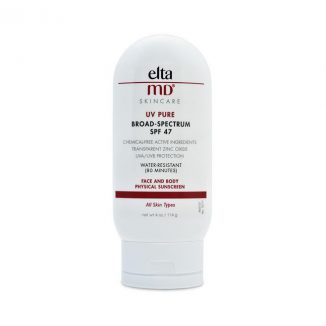The summer heat is hard to avoid in Florida. While finding shade or staying indoors (with A/C!) are always good sun protection options for your skin, it is often hard to avoid the blazing Florida sun. Sun exposure is the most preventable risk factor for skin cancer and the main cause for premature aging. It’s never too late to start protecting yourself! Here are answers to a few commonly asked questions:
What are the types of UV rays?
Radiation from the sun comes in two main forms: UVA rays and UVB rays. UVA is the main cause of skin aging, while UVB is the main cause of sunburns and skin cancers. Any sunscreen you use should say “broad spectrum”, which means that it protects against both UVA and UVB rays.
What are the different types of sunscreen?
There are two main types of sunscreen: chemical and physical blockers. Chemical sunscreens, such as Avobenzone or Oxybenzone, absorb UV rays, while physical blockers create barrier on the skin to reflect UV rays. We usually recommend physical blockers, such as zinc and titanium dioxide, as they work immediately when applied to the skin, are more stable in the sun, and have an even broader coverage of UV rays. Chemical blockers were more cosmetically appealing in the past. However, now zinc is micronized, allowing a smoother application without a white nose!
What is SPF?
SPF stands for “Sun Protective Factor” and refers to protection from UVB rays, which cause sunburns and skin cancers. SPF does not refer to protection from UVA, which causes skin aging. Higher SPF implies more protection, but not proportional to the SPF number. For example, SPF 15 blocks 93 percent of UVB radiation, while an SPF 30 sunscreen blocks 97 percent. Most people apply about half of the recommended amount of sunscreen needed to protect equivalent to the SPF. Therefore, the actual SPF is only about half of the labeled value.
Is higher SPF really better?
Patients commonly ask me, “is SPF higher than 30 really better?” There is a common misconception that any sunscreen with higher SPF does not necessarily protect the skin better. However, a recent study performed in skiers in Vail, Colorado confirmed the advice I have been giving to my patients for years: higher really is better. 199 adults used SPF 100 on one side of their face and SPF 50 on the other side of their face. The researchers found that “The SPF 50 side of the face was 11 times more likely to be sunburned than the SPF 100 side.” Likely, the difference between the two sunscreens was due to the fact that many people do not apply their sunscreen in adequate amounts. The higher SPF sunscreen compensates for this issue in application, thereby protecting the skin from sunburn more consistently. Remember, it is important to choose sunscreens that are broad spectrum, protecting from both UVA and UVB rays from the sun, and reapply your sunscreen liberally, every two hours.
What is UPF?
Sun protective clothing is now stylish, popular and affordable. UPF stands for “Ultraviolet Protection Factor” provided by fabric. This is dependent on many factors, including the tightness of the weave, color, stretch and weight of the fabric. A fabric with UPF 50 allows only 1/50 (or 2%) of the UV rays to pass through the fabric. We highly recommend sun protective clothing, such as Coolibar, as a great addition to your wardrobe this summer.
Do we need sun exposure to maintain adequate Vitamin D levels?
Vitamin D has been in the news a lot, as it is critical to healthy bones. However, the American Academy of Dermatology recommends that an adequate amount of vitamin D should be obtained from a healthy diet and/or vitamin D supplements and should NOT be obtained from unprotected exposure to ultraviolet radiation. If one insists on getting vitamin D from the sun, in Florida only 5-10 minutes a day of sun on the arms and legs are needed to make enough vitamin D, which can easily be achieved during daily activities. After this time, further UV exposure has the reverse effect, breaking down vitamin D into inactive compounds.
Do my car window tints protect against UV rays?
Not all sun exposure is at the beach or having fun outside. You may be getting most of your sun damage when you don’t even realize it – when you are in your car. In cars, windshields are laminated and filter out UVA but side windows are not. Therefore, patients in the US have more sun damage on their left side due to UVA radiation penetrating through the driver-side car window. Llumar, FormulaOne, and 3M are just a few companies that make clear or tinted UV blocking films for car or house windows. You can simply ask your car dealership to add this film on your next service.
As always, prevention is better than cure. Choosing the right type of sunscreen for you is a step in the right direction. For more information on how we can help you with skin protection and sun damage treatments give one of our Siperstein Dermatology Group specialists a call today at our Boynton Beach office (561-364-7774) or our Boca Raton office (561-955-8885).



